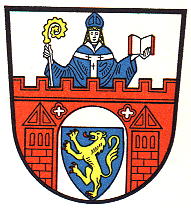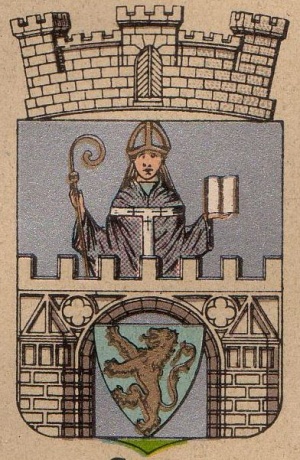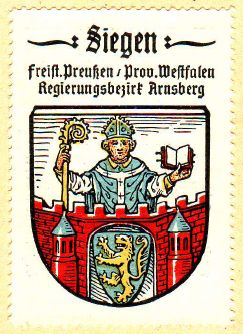Siegen
| Heraldry of the World Civic heraldry of Germany - Deutsche Wappen (Gemeindewappen/Kreiswappen) |
SIEGEN
State : Nordrhein-Westfalen
District (Kreis) : Siegen-Wittgenstein (until 1975 Siegen)
Additions : 1937 Achenbach, Buschgotthardshütten (partly); 1966 Breitenbach, Bürbach, Kaan-Marienborn, Seelbach, Trupbach, Volnsberg; 1969 Feuersbach; 1975 Eiserfeld (1966Amt Eiserfeld, Eisern, Gosenbach, Niederschelden, Oberschelden), Hüttental 1966 Amt Weidenau, Birlenbach, Buchen, Dillnhütten, Geisweid, Langenholdinghausen, Meiswinkel, Niedersetzen, Obersetzen, Sohlbach, Weidenau (1937 Buschgotthardshütten (partly))
Origin/meaning
Siegen received city rights in the early 13th century, and the oldest seal is known since 1248. The arms are based on this oldest seal.
The seal is a combination of the image of the Bishop of Köln, a city wall as a symbol for the city itself and the arms of Nassau in the gate. The city was a possession of the Counts of Nassau and the Bishops of Köln (until 1420). After 1317 the lion of Nassau was surrounded by billets (vertical blocks) of gold, but these were not added to the arms of the city (but still sometimes shown).
The arms were officially granted in 1875. Previously the city used three letters S on its seals.
| Seal of Siegen from 1289 (Meijer, 1940) |
Seal from around 1900 |
The arms as shown around 1900 |
| he arms of Siegen with mural crown (Rühl, 1940) |
The arms in the Kaffee Hag albums +/- 1925 |
Literature : Stadler, 1964-1971; Rühl, 1940; Meijer, 1940; Hupp, O: Kaffee Hag albums, 1920s; <a href="http://www.ngw.nl/catalogue/books/dswDeutsche Städtewappen]] (album around 1900)






